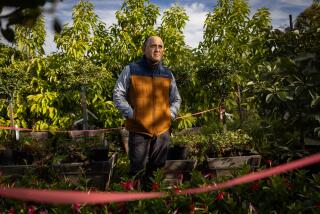Chilled Melons
- Share via
For most of us, when the temperature hits the upper 80s, it’s time to turn on the air conditioning. For melons, that’s still downright chilly.
The recent spell of “cool” weather in the western San Joaquin Valley has pushed back the start of the highly touted Westside melon harvest, originally planned for next week, to July 10-15. The Westside area--roughly stretching along the 5 Freeway--has long been regarded as prime picking country for melons.
“The ideal climatic conditions for us would be warm weather--temperatures over 100 degrees, evenings over 80 degrees--with low humidity,” says Fran Torigian, sales manager of DFI Marketing, a melon packer in Huron.
After two tough years, melon growers are hoping this year will allow them to get back on their feet. Two years ago, the harvest was devastated by a late-season virus. Last year, it was weather woes as spring rains delayed planting, meaning a large volume of melons was harvested all at once, driving prices into the basement.
Once the weather warms up, growers are predicting a long, even season with moderate prices. The harvest should be just a little under last year’s record total.
Forty or 50 years ago, Mendota melons were the ones to look for. Now, the area has spread north as far as Los Banos and south to Huron. During the thick of the Westside harvest--roughly from mid-July to early October--as much as 80% of the melons sold in the U.S. come from this area.
As far as picking a good cantaloupe in the market, the net’s the thing. “Look at the net,” says Gary Connolly, sales manager at Pappas & Co., a Mendota packer. “You want a good high net and good straw color, no green cast at all. And you want the melon to smell a little musty.”
Berj Moosekian, of V.H. Azhderian & Co. in Los Banos, agrees. “The netting should be covering the whole surface of fruit and it should be raised, like looking down on a mountain range. Also check the stem end. There should be no part of the stem left inside of the belly button. If there’s anything left there, the melon was pulled too green.”
Things are a little tougher with honeydews. Because honeydews are cut from the vine, the stem end holds no clues. There’s also no netting on a honeydew, but Torigian says a good honeydew should have “a nice smooth feel without any fuzz.” Also look for a melon with a cream or white color.
At the farmers markets, check honeydews for amber flecking, which indicates a melon with a very high sugar content. You won’t find it in most grocery stores, though. It seems that most produce managers regard so-called sugar-netting as a cosmetic defect and reject any melons that show it.
Despite news reports of outbreaks in other states of the cyclospora bacteria linked to California strawberries, there have been no reported illnesses in Southern California. In fact, the evidence linking the existing outbreaks and strawberries is extremely tenuous. If you have questions, call the Alliance for Food and Fiber Cyclospora hotline at (800) 262-4189 for a recorded message.







